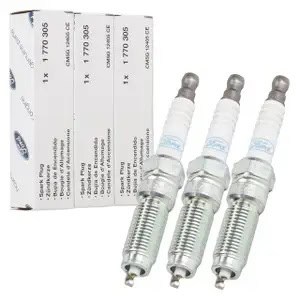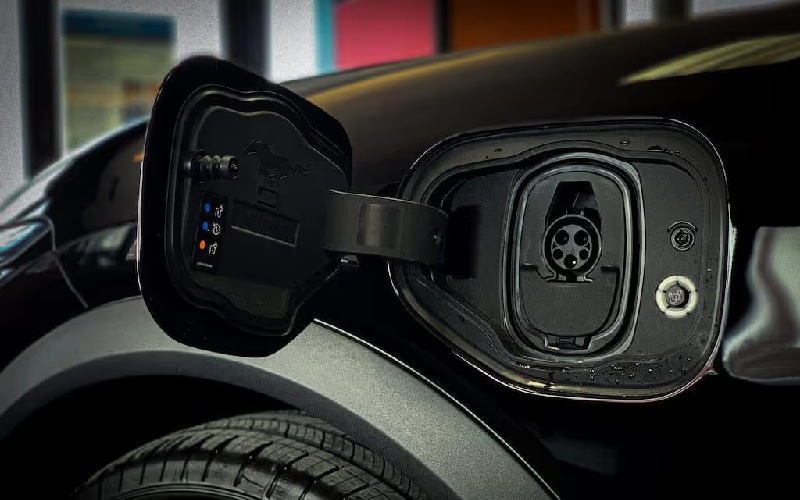Ford EcoSport EcoBoost 1.0 Spark Plugs: Engine Performance
The Ford EcoBoost 1.0-liter engine is a technological marvel that has revolutionized the concept of small displacement engines. This three-cylinder powerplant combines turbocharging, direct fuel injection, and variable valve timing to deliver impressive performance and efficiency. Key specifications of the EcoBoost 1.0 engine include: This compact engine delivers performance comparable to larger, naturally aspirated engines […]
The Ford EcoBoost 1.0-liter engine is a technological marvel that has revolutionized the concept of small displacement engines. This three-cylinder powerplant combines turbocharging, direct fuel injection, and variable valve timing to deliver impressive performance and efficiency.

Key specifications of the EcoBoost 1.0 engine include:
- Displacement: 999 cc (61 cubic inches)
- Number of cylinders: 3
- Valve configuration: 12 valves, DOHC (Double Overhead Camshaft)
- Maximum power: 92 kW (123 HP / 125 PS) at 6000 rpm
- Maximum torque: 170 Nm (125 lb-ft) at 1400 rpm
- Fuel system: Direct Injection
- Aspiration: Turbocharged with Intercooler
This compact engine delivers performance comparable to larger, naturally aspirated engines while maintaining excellent fuel efficiency. The EcoSport EcoBoost 1.0 has found its way into various Ford models, including the EcoSport, making it a versatile and popular choice among consumers.
The Role of Spark Plugs in the EcoBoost 1.0
Spark plugs are critical components in any gasoline engine, and their importance is even more important in a high-performance, turbocharged engine like the EcoBoost 1.0. These small devices ignite the air-fuel mixture in the combustion chamber, initiating the power stroke that drives the engine.
In the EcoBoost 1.0, spark plugs face unique challenges:
- High combustion pressures: The turbocharger increases the pressure in the combustion chamber, requiring spark plugs to withstand higher stress levels.
- Frequent temperature changes: The small engine size and turbocharging lead to rapid temperature fluctuations, which the spark plugs must endure without failing.
- Precision ignition timing: To maximize efficiency and power, the EcoBoost 1.0 relies on precise ignition timing, making the performance of spark plugs crucial.
Spark Plug Specifications for the EcoBoost 1.0
Ford has carefully selected spark plugs that can meet the demanding requirements of the EcoBoost 1.0 engine. The official specifications for these spark plugs are:
- Spark plug gap: 0.026 – 0.030 in. (0.65 – 0.75 mm)
- Compression ratio: 10.0:1
These specifications are crucial for proper engine operation. The spark plug gap, in particular, is vital as it affects the spark’s intensity and the flame front propagation in the combustion chamber. A gap that’s too wide can lead to misfires, while a gap that’s too narrow may result in poor fuel economy and reduced power output.
Maintenance and Replacement Intervals
One of the most common questions among Ford EcoSport EcoBoost 1.0 owners is how often they should replace their spark plugs. While the Ford official maintenance schedule should always be the primary reference, there are some general guidelines and considerations to remember.
Standard Interval:
Modern spark plugs are traditionally designed to last for extended periods, often up to 150,000 kilometers, in many vehicles. However, the high-performance nature of the EcoBoost 1.0 engine may necessitate more frequent replacements.
Factors Affecting Replacement Frequency:
- Driving conditions: Frequent short trips, stop-and-go traffic, and extreme temperatures can accelerate spark plug wear.
- Fuel quality: Using lower-grade fuel can lead to deposits on spark plugs, reducing their lifespan.
- Engine modifications: If the engine has been tuned or modified for higher performance, spark plugs may need more frequent replacement.
- Symptoms of wear: Misfires, rough idling, or decreased fuel efficiency can indicate that spark plugs need replacement, regardless of mileage.
Recommended Practices:
While some sources suggest frequent replacements (as often as every 30,000 kilometers), this is generally considered excessive for stock EcoSport EcoBoost 1.0 engines. A more reasonable approach would be:
- Follow the official Ford maintenance schedule as a baseline.
- Inspect spark plugs every 50,000 to 65,000 kilometers for signs of wear or deposits.
- Replace spark plugs preemptively around 100,000 to 130,000 kilometers, even if they appear to function well.
- Consider more frequent inspections and replacements for high-performance or heavily modified engines, potentially every 30,000 to 50,000 kilometers.
It’s important to note that unnecessary frequent replacements can potentially lead to issues such as stripped threads in aluminum cylinder heads, so following manufacturer recommendations is crucial.
The Impact of Spark Plugs on EcoBoost 1.0 Performance
The condition and quality of spark plugs have a significant impact on the EcoBoost 1.0 engine’s performance, fuel efficiency, and emissions. Here’s how spark plugs influence various aspects of engine operation:
- Power Output: Well-maintained spark plugs ensure complete combustion of the air-fuel mixture, allowing the engine to produce its maximum power. Worn or fouled spark plugs can lead to incomplete combustion, resulting in power loss and sluggish acceleration.
- Fuel Efficiency: Properly functioning spark plugs contribute to optimal fuel burn, maximizing the energy extracted from each drop of fuel. This efficiency is crucial for maintaining the EcoBoost 1.0 reputation for excellent fuel economy.
- Emissions: Clean and correctly gapped spark plugs promote complete combustion, reducing harmful emissions. This is particularly important for the EcoBoost 1.0, which meets stringent emission standards, including Euro 6 regulations.
- Engine Smoothness: Consistent spark plug performance across all three cylinders ensures smooth engine operation. Misfires or inconsistent ignition can lead to noticeable vibrations and rough idling.
- Cold Starts: High-quality spark plugs with the correct heat range help ensure reliable cold starts, especially important in colder climates.
- Turbocharger Longevity: By maintaining proper combustion, good spark plugs help prevent unburned fuel from entering the exhaust system, which can damage the turbocharger over time.
Choose the Right Spark Plugs for Your EcoSport EcoBoost 1.0
When it’s time to replace your spark plugs, selecting the right ones is crucial. Here are some factors to consider:
- OEM vs. Aftermarket: Ford original equipment manufacturer (OEM) spark plugs are specifically designed for the EcoBoost 1.0 engine. While they may be more expensive, they ensure compatibility and optimal performance. High-quality aftermarket options from reputable brands can also be suitable, but it’s essential to verify their specifications match Ford requirements.
- Material: Modern spark plugs often use precious metals like platinum or iridium for the electrodes. These materials offer better durability and performance compared to traditional copper plugs. For the high-stress environment of the EcoBoost 1.0, iridium spark plugs are often recommended for their longevity and consistent performance.
- Heat Range: The spark plug’s heat range must match the engine’s specifications. Using plugs with an incorrect heat range can lead to pre-ignition, fouling, or other performance issues.
- Thread Size and Reach: Ensure the replacement spark plugs have the correct thread size and reach for the EcoBoost 1.0 engine to avoid installation problems or damage.
Installation and Maintenance Tips
Proper installation and maintenance of spark plugs are crucial for the EcoBoost 1.0 engine’s performance and longevity. Here are some essential tips:
- Use the Correct Tools: The EcoBoost 1.0 engine may require a specific spark plug socket size. Using the wrong tools can damage the plugs or the engine.
- Torque Specifications: Always follow Ford torque specifications when installing new spark plugs. Over-tightening can damage the cylinder head while under-tightening can lead to compression leaks.
- Gap Verification: Even if the new spark plugs are pre-gapped, verifying the gap before installation is wise. Use a proper gap tool to ensure accuracy.
- Avoid Contamination: Keep the spark plug wells clean during the replacement process to prevent debris from entering the cylinders.
- Inspect Old Plugs: When removing old spark plugs, inspect them for signs of abnormal wear, deposits, or damage, providing valuable insights into the engine’s health.
- Consider Anti-Seize: In some cases, applying a small amount of anti-seize compound to the spark plug threads can make future removals easier. However, always consult your vehicle’s manual, as some manufacturers advise against this practice.
Common Spark Plug Issues in the EcoBoost 1.0
While the EcoBoost 1.0 engine is generally reliable, certain spark plug-related issues can occur:
- Carbon Fouling: Frequent short trips or rich fuel mixtures can lead to carbon deposits on spark plugs, reducing their effectiveness.
- Oil Fouling: Worn piston rings or valve guides allow oil to enter the combustion chamber, coating spark plugs and causing misfires.
- Electrode Wear: Over time, the electrodes on spark plugs wear down, increasing the gap and potentially leading to ignition problems.
- Pre-Ignition: Using spark plugs with an incorrect heat range can cause pre-ignition, potentially damaging the engine.
- Breakage: Improper installation or removal can lead to spark plug breakage, which can be particularly problematic in the compact EcoBoost 1.0 engine bay.
The Future of Spark Plug Technology
As automotive technology advances, spark plug design evolves to meet new challenges. For future iterations of the EcoBoost 1.0 engine, we might see:
- Advanced Materials: Development of new electrode materials that offer even greater durability and performance.
- Integrated Sensors: Spark plugs with built-in sensors to provide real-time data on combustion quality and engine health.
- Laser Ignition: Research into laser ignition systems that could potentially replace traditional spark plugs, offering more precise and efficient combustion.
- Self-Cleaning Mechanisms: Innovations to help spark plugs resist fouling and maintain performance over longer periods.
Ford EcoSport EcoBoost 1.0 Engine: Maintain Performance
The spark plugs in your Ford EcoSport EcoBoost 1.0 engine may be small, but their impact on performance, efficiency, and reliability is significant. By understanding their role, maintaining them properly, and replacing them when necessary, you can ensure that your EcoSport continues delivering the power and efficiency the EcoBoost engine is renowned for.
Regular maintenance, including timely spark plug replacements, keeps your engine running smoothly and contributes to better fuel economy and reduced emissions. As automotive technology continues to evolve, the humble spark plug remains a critical component in the quest for cleaner, more efficient internal combustion engines.
Whether you’re a DIY enthusiast or prefer professional maintenance, paying attention to your EcoSport spark plugs will help you get the most out of your vehicle, ensuring many miles of efficient and enjoyable driving. Remember, a small investment in quality spark plugs and proper maintenance can pay significant dividends in your EcoSport performance and longevity.



